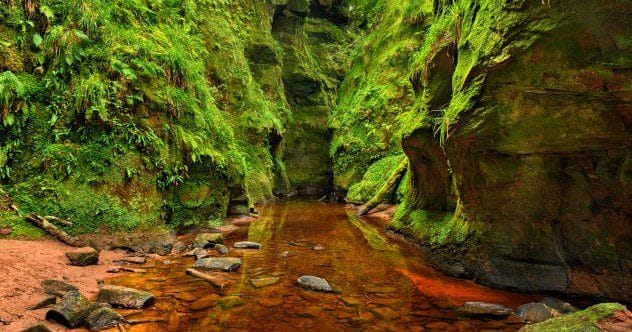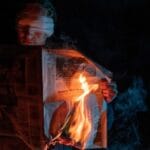The figure of the Devil has cast a long, dark shadow over human history and folklore. It’s no surprise then, that his infamous name is attached to countless places, mysterious objects, and spine-chilling legends across the globe. From ancient fortresses to peculiar rock formations, these devilishly named phenomena offer a glimpse into our fascination with the sinister and the unknown. Are you ready to explore some of the most intriguing?
10. The Devil’s Sentry Box – San Juan, Puerto Rico
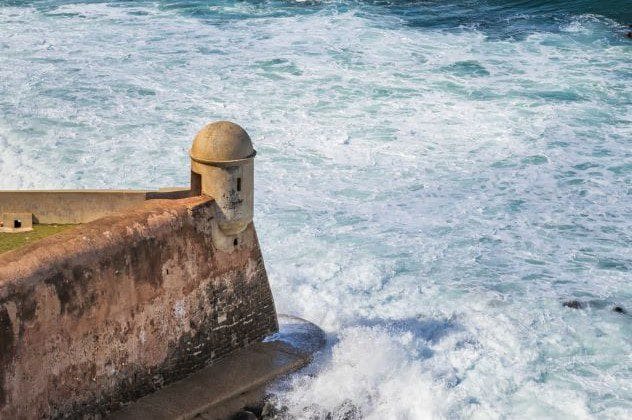
Perched on a northern point of Puerto Rico’s capital, Castillo San Cristobal is an old fortress. It once guarded the island from pirates and played a role in the Spanish-American War. However, its centuries-old history might also include a brush with the Devil himself!
A 17th-century legend tells of a soldier named Sanchez. He was stationed an overnight watch at an isolated sentry box in Castillo San Cristobal. Sanchez was known to play his guitar to pass the lonely hours. One night, during roll call, Sanchez didn’t answer when his name was called.
The other soldier called out again but received no reply. He reported Sanchez missing, yet no one had seen anyone pass by. The men concluded something must have taken him, but they were too scared to search in the dark.
The next morning, soldiers found Sanchez’s rifle and clothes in his sentry box, but he was gone. Some claimed his clothes were burned and that they smelled sulfur. They whispered that the Devil must have snatched him. For nights afterward, some soldiers reported hearing Sanchez’s guitar playing. Yet, no one was seen entering or leaving the sentry box. The mysterious music was sometimes accompanied by the sound of a demonic laugh!
9. The Devil’s Elbow – Glossop, England
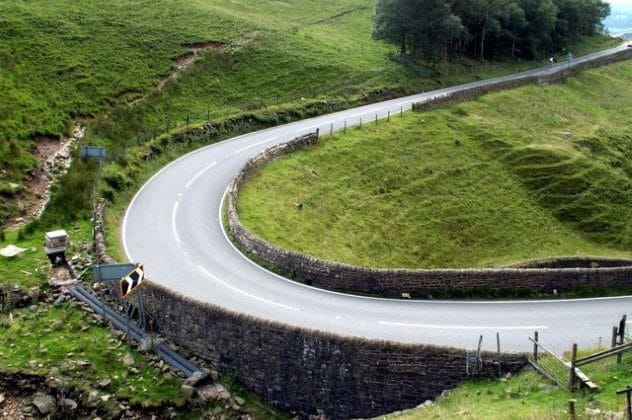
Between Glossop and Woodhead, England, lies a notorious section of the B6105 road known as the Devil’s Elbow. It earned its name due to a very sharp, dangerous curve. This spot is also the setting for a chilling local legend.
The story goes that the Devil’s Elbow was a secret meeting place for a young couple. The woman’s father strongly disapproved of their relationship. He angrily declared he’d rather see his daughter taken by the Devil than meet her lover again. As the old saying warns, be careful what you wish for!
The next time the couple met at their usual spot, the Devil himself suddenly appeared. He chased the terrified pair across the moor. As the Devil tried to grab the woman, his bent arm supposedly turned to stone. In a rage, he ripped off his petrified arm and threw it across the moor. This act is said to have formed the sharp curve in the road now known as the Devil’s Elbow.
8. Robert the Devil – Normandy, France
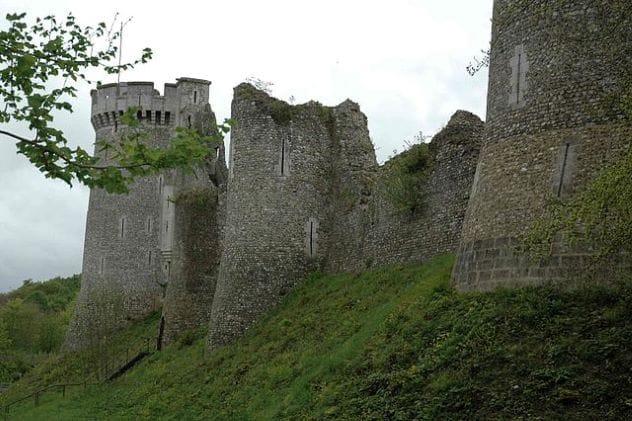
The legend of Robert the Devil dates back to the late 12th or early 13th century. It tells of the Duke and Duchess of Normandy, who longed for a child. After many unanswered prayers to God, their patience wore thin.
In desperation, they turned to the Devil for help. Soon after, their son, Robert Le Diable (Robert the Devil), was born. Because his conception was tied to evil, Robert grew into a cruel and bloodthirsty young man. He gathered a band of ruffians and wreaked havoc, even committing a terrible crime that cost seven hermits their lives.
One day, Robert had a sudden realization of his wickedness. It was then his mother confessed the truth about his birth. He tried to convince his companions to abandon their evil ways, but they refused. So, he killed them and journeyed to Rome. The Pope sent him to a hermit, who prescribed a harsh penance: Robert had to feign being mute and mad, and even fight with dogs for food.
He later worked incognito as a jester in the emperor’s palace. An angel secretly aided him, providing armor so he could fight against the Saracens and save Rome. The emperor, impressed by the mysterious hero, offered him the crown and his daughter’s hand in marriage. Robert, now free from his penance, married the princess. They returned to Normandy, where Robert rescued his widowed mother. He also avenged his father-in-law’s murder in Rome. Robert and his wife reportedly lived happily ever after, and had a son named Richard. You can still visit the remains of Château de Robert le Diable, a feudal castle from that era, located near Rouen.
7. The Devil’s Pit – Aukštadvaris, Lithuania
The Devil’s Pit is a remarkably deep sinkhole located in Lithuania’s Aukštadvaris Regional Park. This area boasts an ancient and unique history, with settlers arriving as early as the 2nd and 3rd centuries BC. The Devil’s Pit itself is shrouded in mystery; even its origins remain unknown.
Legends and speculations about the pit have been passed down through generations. Science has yet to provide a definitive explanation for its formation. One hypothesis suggests a rock-covered glacier thousands of years ago. As the glacier melted, a massive cavity began to form. Another theory proposes that a melting glacier created a powerful waterfall. Over time, the sheer force of the falling water might have carved out the deep pit.
And, naturally, the Devil’s Pit has its own devilish legend! It’s said that the Devil once held a midnight feast there. Locals claim that those who walk by the pit at night can still hear screams echoing from its depths.
6. The Devil’s Rocking Chair – Las Vegas, USA
Zak Bagans’s The Haunted Museum in Las Vegas is an award-winning destination for all things haunted, creepy, and weird. Bagans, a well-known figure in supernatural investigation, has dedicated his life to seeking answers about the afterlife using science-based research.
Among the museum’s many eerie exhibits is a rocking chair said to be profoundly evil – the Devil’s Rocking Chair. While its origins and original owner are unknown, it came into the possession of the Glatzel family in the 1950s. Subsequently, two members of the Glatzel family reportedly became possessed by demonic forces, and the rocking chair is believed to be at the center of these terrifying events.
The first alleged possession occurred in 1980. Eleven-year-old David Glatzel awoke one night in distress, claiming he’d seen a ghostly figure that was part animal, part human, with hooves, horns, and a gaunt face with sharp teeth. His mental state deteriorated rapidly. He began seeing this figure, which he called “the beast,” everywhere, even during the day. The beast’s favorite spot, David said, was the rocking chair. His family claimed they witnessed the chair rocking back and forth on its own when empty.
The family eventually called a priest to perform an exorcism, but this reportedly only angered the spirit. Famed paranormal investigators Ed and Lorraine Warren were then brought in. With the help of other priests, they successfully banished the entity from David’s body. However, the ordeal wasn’t over for the Glatzels. David’s sister’s fiancé, Arne Johnson, began exhibiting similar disturbing behavior. The family concluded the same spirit had entered Arne. Arne’s alleged possession was far worse, culminating in him killing his landlord. In court, his defense team argued demonic possession, but this plea was dismissed, and he served five years in prison. The Devil’s Rocking Chair is now on display at The Haunted Museum, where demonic entities are said to still surround it. Museum staff report strange occurrences since the chair’s arrival, and visitors are warned to enter at their own risk!
5. The Devil’s Fingerprints – Blythburgh, England
On August 4, 1577, the villagers of Blythburgh, Suffolk, England, were gathered for Sunday services. Suddenly, a violent storm struck the town and battered the Holy Trinity Church. Lightning struck the church repeatedly, causing the spire to collapse through the roof onto the congregation below.
Amidst the chaos and terror, it’s said that a huge, shaggy black dog appeared. Known as Black Shuck (from the Old English word “scucca,” meaning “devil”), this fearsome creature reportedly attacked some parishioners before vanishing down the center aisle and out of the church. The entity left long, black scratch marks on the wooden church doors. These marks became locally known as “The Devil’s Fingerprints” and are still visible today.
However, researchers and experimental archaeology suggest a more mundane explanation. These marks were likely made intentionally with a hot taper or candle. Ironically, such marks were probably intended to protect the church against demons and curses, rather than being evidence of a demonic visitation.
4. The Devil’s Bit – Glenreagh, Ireland
Nestled in the hills of County Tipperary, Ireland, the Devil’s Bit is a noticeable gap in a mountain. This rock formation atop a plateau looks as if a giant chunk has been bitten out of it. Local legend attributes this unique feature to the Devil himself.
The story goes that the Devil took a bite out of the mountaintop. The bite was so forceful it broke one of his teeth. He then spat the tooth out, and it landed 20 miles (32 kilometers) south, forming the famous Rock of Cashel, another significant Irish landmark. While the gap in the mountain is, in reality, a geological oddity, this region of Ireland is rich with myths and folklore.
One such myth, adding to the area’s mystique, claims that an 8th-century edition of the four Gospels, known as the Book of Dimma, was discovered near the Devil’s Bit in 1789. It’s uncertain whether such an ancient document could have survived the local conditions, but the alleged discovery highlights the intriguing nature of this place.
3. The Devil’s Claw Marks – Island of Sanday, Scotland
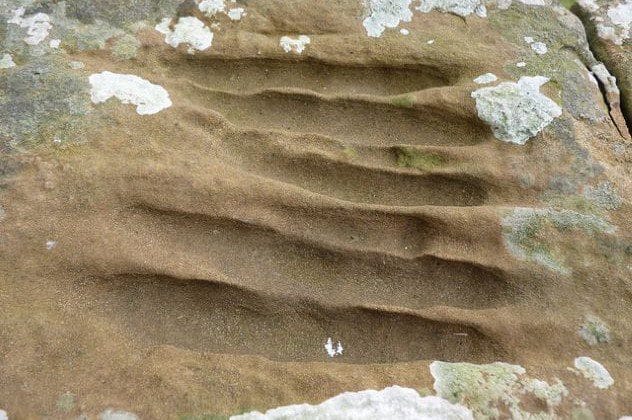
On the Scottish island of Sanday lies Lady Village. Its parish church is now a roofless ruin, but visitors can still climb the stone steps that once led to its upper level. At the top of these steps, a peculiar sight awaits: a stone bearing huge, deep marks, as if something with incredibly strong claws scratched it violently!
Local legend tells of a minister in the village who preached fervently against sin, particularly adultery. However, this very minister was secretly engaging in the same sins he condemned from the pulpit. One night, as he was leaving his mistress’s house, he found the Devil himself waiting to drag him to hell.
Terrified, the minister fled back to the church. He managed to slam the door shut just before the Devil could get inside. Enraged at being thwarted, the Devil scratched furiously at the stone by the door, leaving the deep marks that are still visible today. It’s a stark reminder, as they say, to practice what you preach.
2. The Devil’s Pulpit – Craighat, Scotland
Finnich Glen in Scotland is a striking, narrow gorge, home to water that runs a startling blood-red color. Within هذا glen, a peculiar, mushroom-shaped rock formation stands out, and it comes with its own sinister legend. This rock has been given the ominous moniker “The Devil’s Pulpit.”
Folklore claims this was the very spot where the Devil stood to address his followers. Other myths suggest it was a place for secret meetings held by Druids. Some even say the rock was used as an execution block by witches. The blood-red water certainly adds to the glen’s ominous atmosphere. However, the water’s color isn’t due to any diabolical influence; it’s simply a result of the red sandstone bedrock of the glen.
1. The Devil’s Gate – Wyoming, USA
Carved by the Sweetwater River in Natrona County, Wyoming, the Devil’s Gate is a dramatic limestone rock passage. It measures an impressive 1,500 feet (457 meters) in length. During the 1800s, it served as a crucial landmark for fur traders and pioneers on westward emigrant trails, including the California, Oregon, and Mormon trails.
The name “Devil’s Gate” might have originated because the treacherous passage was thought to be the location of several murders. However, a more colorful legend was reported in 1843 by a New Orleans journalist. This tale suggests a sinister beast once prevented Native Americans from hunting in the area. A courageous warrior decided to confront the creature. He tracked the beast, which became so enraged that it used its massive tusks to tear the passage through the rock as it escaped.
With the advent of cars, trains, and airplanes, these historic trails eventually fell into disuse. The land encompassing Devil’s Gate was later acquired by a Mormon church. They established a public center there to educate visitors about the significance of the passage and the travelers who once relied on it.
These ten examples are just a handful of the many places, objects, and legends that bear the Devil’s name. Whether born from genuine fear, playful folklore, or attempts to explain the unexplainable, they remind us of the powerful role such figures play in our collective imagination. Each story, each location, adds another layer to the rich tapestry of human culture and our enduring fascination with the darker side of lore.
Which of these devilish tales intrigued you the most? Do you know of other places or legends named after the Devil? Leave your comment below and share your thoughts!


